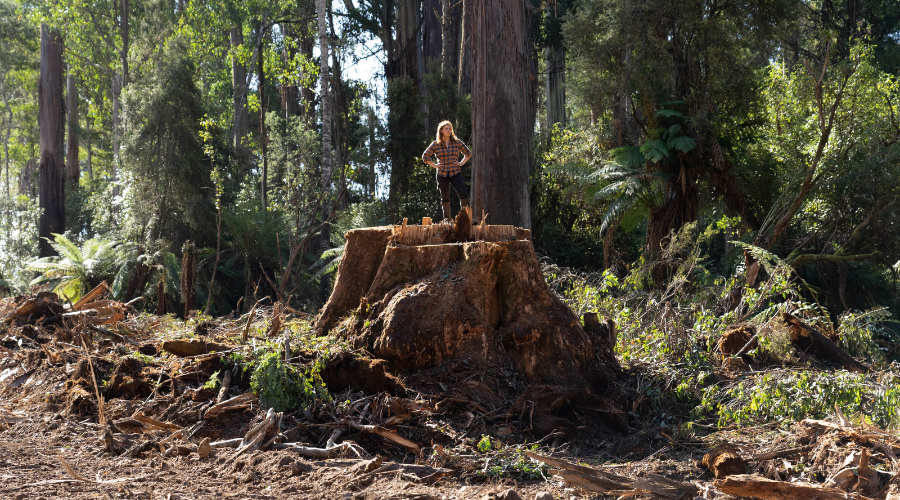News - 05 May 2023
Logging the last giants: Weak regulation enables Forestry Tasmania to repeatedly break its own rules

Disturbing new evidence of logging by Forestry Tasmania in the concealed upper Styx and Florentine region has been revealed by citizen scientists. The evidence suggests several breaches of the Forest Practices Code, including logging across a stream and the logging of large trees, in breach of Forestry Tasmania’s large tree retention policy.
Survey reports (SX019D & FO020B; TN031B) evidencing the breaches have been provided to the Forestry Practices Authority and Forestry Tasmania, but there is yet to be a response. The reports provide evidence of six large tree stumps over 2.5m in diameter. In another area, the citizen scientists found evidence of an alleged breach of the Forest Practices Code, where Forestry Tasmania failed to implement the required buffer between the stream and the logged trees.
The citizen scientists also found many undocumented large trees in an unlogged coupe, adjacent to the Maydena Bike park. They found a 19m circumference and 60m tall tree on the edge of the coupe boundary, which qualifies as a giant tree under Forestry Tasmania policy, and should have been properly identified and documented in order to receive a 100m protective buffer zone. The surveyors also found a further 21 trees over 2.5m in diameter.
Forestry Tasmania and the Forest Practices Authority are exempt from the national environmental laws and act as if they are self-regulated when the law does not allow them to be.
“Citizens should not have to do the government's surveying work for them,” said Alice Hardinge for the Wilderness Society.
“Forestry Tasmania unlawfully conducts itself so that there is no one to hold it to account when it breaks its own rules.
“Worse still, this regime is backsliding and becoming less transparent by making information about its publicly-funded activities on public-land harder to access. For example, logging plans are now no longer made publicly available on the Forestry Tasmania website and requests are frequently ignored.
“Forestry Tasmania says that it doesn't log giant trees. Yet every other week, Tasmanians see giant single-log loads on the back of trucks, and concerned citizens find giant stumps in public state forests,” said Ms Hardinge.
Steve Pearce from The Tree Projects, said: “Tasmania is home to some of the world’s largest trees. These trees can tower over 100 metres tall and can grow up to 22 metres in circumference. These giants should be forming the backbone of the tourism economy in regional towns. But time and time again STT fails to adequately manage these valuable assets.
“The importance of native forest logging to the economy has been overstated for decades and costs the taxpayer millions of dollars each year. Instead of logging some of the largest trees on earth, we, as Tasmanians, should be celebrating them. A low impact sustainable Big Tree Tourism industry could easily be developed and replace this outdated and unpopular industry. Big Tree tourism is worth much more to this island than logging it for a loss,” added Mr Pearce.
The question of whether the forest practises plans that govern this logging activity are being managed illegally remains before Tasmania’s Supreme Court, thanks to cases brought by Blue Derby Wild and the Wilderness Society Tasmania.
Potentially illegal, certainly unethical and definitely unsustainable wood taken from High Conservation Value forests that are repeatedly logged in breach of the Forest Practices Code continues to flow from the forests of Lutruwita / Tasmania into shops, people’s homes and markets on the mainland and overseas.
For further comment contact Alice Hardinge on 0421 819 679